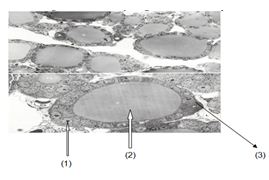Chemical Coordination and Integration - Online Test
Q1. The following slide is of Transverse section of thyroid gland and it shows [from left to right] :


Answer : Option C
Explaination / Solution:
Transverse section of thyroid gland shows mark (1) as follicular epithelium, mark (2) as colloid containingthyroglobuin and mark (3) as clear cells.
Q2. Following conversion in forward and backward directions is regulated as :
Blood calcium Bone calcium
Answer : Option C
Explaination / Solution:
Thyrocalcitonin (TCT) influence the metabolism of calcium inside the body. Parathyroid hormone (PTH) absorption of calcium in bone.
Q3. To exert their effect on the target cell, water soluble hormones will need to bind with
Answer : Option B
Explaination / Solution:
Hormone receptors present on the cell membrane of the target cells are called membrane-bound receptors and the receptors present inside the target cell are called intracellular receptors, mostly nuclear receptors (present in the nucleus). Binding of a hormone to its receptor leads to the formation of a hormone-receptor complex.
Q4.
Secretion of aldosterone is stimulated by :
i. decrease in sodium ion concentration in the plasma.
ii. decrease in potassium ion concentration in the plasma.
iii. decrease in the volume of blood.
Answer : Option C
Explaination / Solution:
If decreased blood pressure is detected, the adrenal gland is stimulated by these stretch receptors to release aldosterone, which increases sodium reabsorption from the urine, sweat, and the gut. This causes increased osmolarity in the extracellular fluid, which will eventually return blood pressure toward normal.
Q5.
Read the following statements about suprarenal glands :
i. A suprarenal gland represents two endocrine glands arranged in one organ.
ii. It’s outer region secretes steroid hormones.
iii. Also known as gland of emergency.
Answer : Option B
Explaination / Solution:
The adrenal glands (also known as suprarenal glands) are endocrine glands that produce a variety of hormones including adrenaline and the steroids aldosterone and cortisol. They are found above the kidneys. Also Known as the emergency gland of the body.This is because it produces a homone called ADRENALIN which prepares our body from emergencies
Q6. A person accidentally got his adrenal gland injured. He died & reports will probably reveal that death was caused due to :
Answer : Option B
Explaination / Solution:
Adrenal cortex is situated along the perimeter of the adrenal gland. The adrenal cortex mediates the stress response through production of aldosterone and cortisol. If a person got injured his adrenal gland may die due to loss of stress response which will be reveled in report.
Q7. Which of the following scientists won the nobel prize for discovering second messengers?
Answer : Option D
Explaination / Solution:
Second messengers are molecules that relay signals received at receptors on the cell surface to trigger physiological changes.
The Nobel Prize in Physiology or Medicine 1971 was awarded to Earl W. Sutherland, Jr. "for his discoveries concerning the mechanisms of the action of hormones".
Q8. Which of the following gas is found to work as a second messenger?
Answer : Option A
Explaination / Solution:
Second messengers are molecules that relay signals received at receptors on the cell surface to trigger physiological changes. Nitrogen oxide (NO) acts as second messenger.
Q9. Read the following statements :
i. endocrine system corrects the imbalance originally detected by the nervous system.
ii. nerve cells and endocrine cells exist side by side in adrenal gland and pituitary.
i. endocrine system corrects the imbalance originally detected by the nervous system.
ii. nerve cells and endocrine cells exist side by side in adrenal gland and pituitary.
Answer : Option A
Explaination / Solution:
Endocrine system corrects the imbalance originally detected by the nervous system. Nerve cells and endocrine cells exist side by side in adrenal gland and pituitary gland.
Q10. Glucose will be lost in the urine of patients suffering from :
Answer : Option C
Explaination / Solution:
Glucose will be lost in the urine of patients suffering from diabetes mellitus. It a chronic lifelong condition that affects our body ability to use the energy found in blood.
